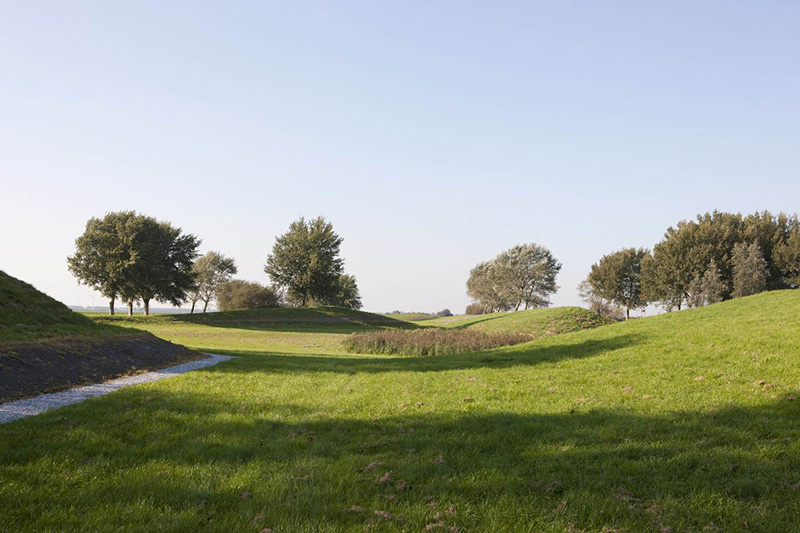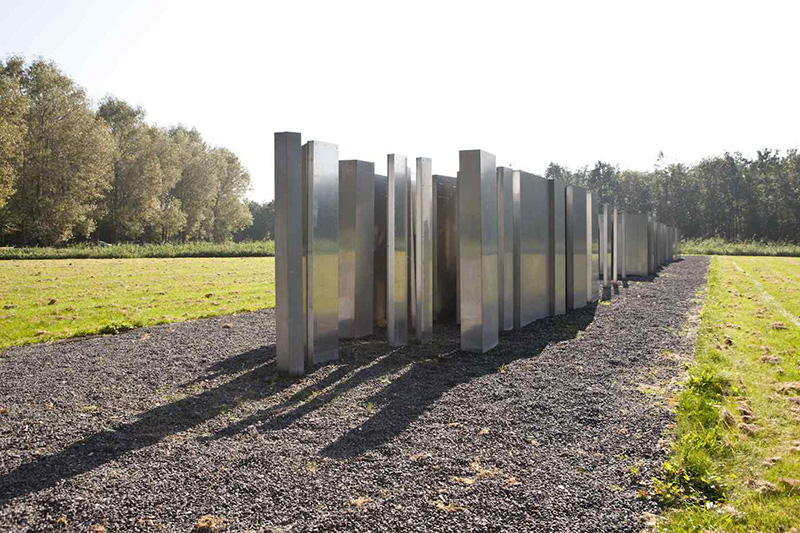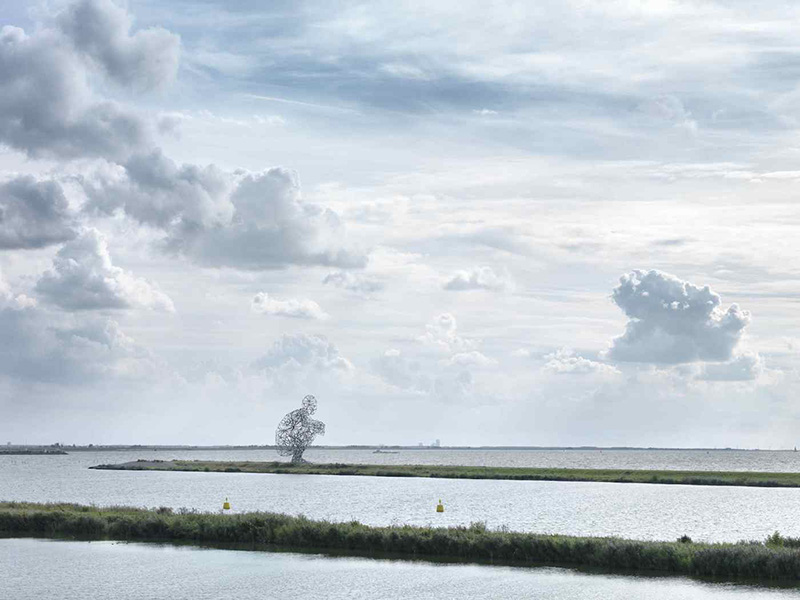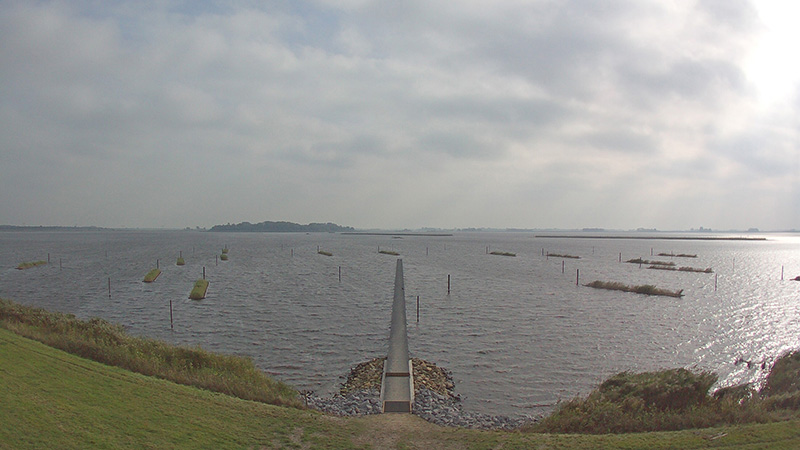ART-TRIBUTE:40 years of Land Art in Flevoland
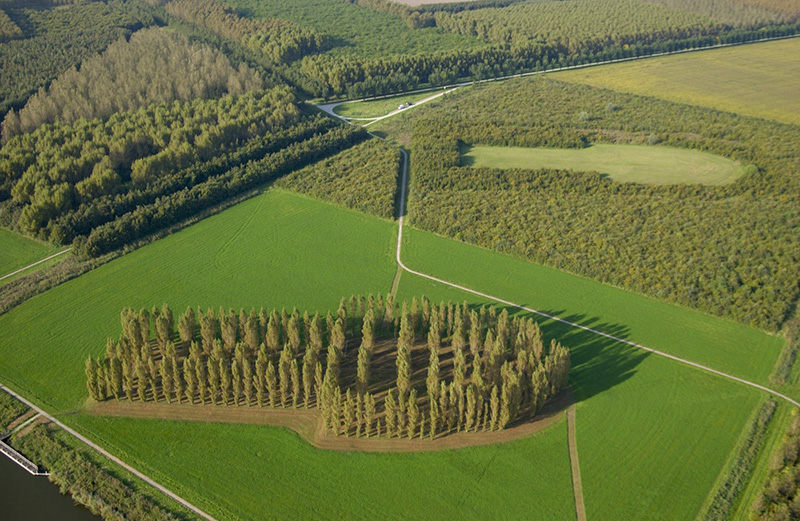 During the building of the Flevoland polder* in Netherlands, the engineers and planners decided to mark the occasion through the realisation of seven Land Art works, situated on several locations. An art form popular in the United States in the ‘70s and introduced in the Netherlands through exhibitions such as “Op Losse Schroeven” (1969) in the Stedelijk Museum Amsterdam and “Sonsbeek Buiten de Perken” (1971) in Arnhem.
During the building of the Flevoland polder* in Netherlands, the engineers and planners decided to mark the occasion through the realisation of seven Land Art works, situated on several locations. An art form popular in the United States in the ‘70s and introduced in the Netherlands through exhibitions such as “Op Losse Schroeven” (1969) in the Stedelijk Museum Amsterdam and “Sonsbeek Buiten de Perken” (1971) in Arnhem.
By Efi Michalarou
Photo: Land Art Flevoland Archive
In the exhibition “Once more, with feeling”, presented at KAF Expo in Almere, the seven landscape artworks and performances come together in an exhibition that celebrates forty years of Land Art in Flevoland. Monumental sculpture, photography and video – historical documents, volatile moments and social issues: an opportunity to experience everything in one place in space and time. Land Art artists: Marinus Boezem, Antony Gormley, Paul de Kort, Daniel Libeskind, Robert Morris, Richard Serra, Piet Slegers. Land Art Live performance artists: Feiko Beckers, Melanie Bonajo, Gilles de Brock, Zhana Ivanova, Cindy Moorman, Maria Pask, Rory Pilgrim. The Land Art works in chronological order are: Robert Morris “Observatory” (1977): The work was previously realized in Velsen in the frame of the large exhibition “Sonsbeek Buiten de Perke”n (1971), but had to make way for a new construction project. In collaboration with the Stedelijk Museum Amsterdam, it was decided to recreate it in Lelystad, in the then vast, empty landscape. The artwork references prehistoric sites that were used for the observation of the sun and the planets, such as Stonehenge in England. The artwork consists of two concentric earthen ramparts. Three V-shaped incisions made in the circles offer a view on the polder landscape. At the beginning of spring and autumn, when day and night are equally long, the middle steel visor is perfectly aligned with the rising sun. The stone wedges on both sides are in turn aligned with the rising sun on June 21st and December 21st, the summer and winter solstices. Piet Slegers “Earth Sea” (1982): With its five hectares, roughly as large as the surrounding plots of farmland, “Earth Sea” is one of the biggest artworks in the Netherlands. The artwork can be accessed by means of two footbridges. The work feels like an oasis of tranquillity in the open polder. It lies amidst the flat fields like a frozen movement of the seabed. The water surface of the pond is the only horizontal surface amidst the sloping surroundings. Slegers’ landscape artwork refers to the transformation of the wild Zuiderzee into the serene polder landscape and the dialogue between the elements of earth and water. “Sea Level” (1996) by Richard Serra sits like a spirit level in the middle of the rolling land- scape of park De Wetering in Zeewolde. The two concrete walls run straight through the park, which was designed in 1986 by landscape architect Pieter van der Molen and artist Bas Maters. The walls, each 200 metres long, are diagonally aligned along both sides of a canal. At their outer ends, the walls disappear almost invisibly into the landscape, whereas in the middle _ at the park’s lowest point _ they are several metres high. “Sea Level” gives physical meaning to the term sea level: without the dikes the water level would come up to the upper edge of the walls. The artwork evokes a feeling of submersion; visitors walking along the wall are made to feel as if they are literally ‘going under’, only to ‘resurface’ a little further down. Marinus Boezem “The Green Cathedral” (1996): Squarely set within Flevoland’s geometric polder, is a ‘gothic’ cathedral. No sky-high stone vaults, metre-high stained glass windows with divine scenes or echoing corridors, but a cathedral formed by a group of Italian poplars. Artist Marinus Boezem developed the idea for this Gothic Growing Project in 1978. In 1987, upon the invitation of the engineers of the Rijksdienst IJssel- meerpolders (RIJP), he planted 178 poplars according to the ground plan of the Notre-Dame of Reims. Between the trees, concrete paths have been laid out, reminiscent of the ribs of the cross vaults. The circles of shells around the trees refer to the sea that covered this entire area only half a century ago. Much like the Gothic cathedral, Boezem sees the creation of the Flevoland polder on the bottom of the former Zuider- zee as the pinnacle of human achievement. Daniel Libeskind “Polderland Garden of Love and Fire” (1997): Five intersecting lines mark the landscape in Almere Pampus like a strange pictorial sign. Three narrow canals, a footpath and a strip of black gravel upon which is set a sculpture that consists of aluminium walls make up the “Polderland Garden of Love and Fire” by architect Daniel Libeskind. One of the greatest Spanish mystics and poets, Juan de la Cruz (1542-91) inspired Libeskind with his poem “The living flame of love”. The lines of the artwork connect people in different places and times. The three canals symbolize the imaginary connection between three cities: Salamanca, the city where Juan de la Cruz studied, Berlin, where Libeskind lived and worked at the time, and Almere, the place where the artwork is located. Antony Gormley “Exposure” (2010): Hovering on the edge between land and water, a 26-metre-tall squatting man looks out over the Markermeer. Fascinated by the malleability of the new polder, Gormley found inspiration for this gigantic artwork in the virgin landscape. Driving through the polder, he discovered a rhythm of straight lines formed by canals, fields and wind- mills. Exposure recalls the network of power pylons that is spread across Flevoland like some sort of giant nervous system.The artwork, which resembles a transparent human figure, can already be spotted from quite a distance. As one comes closer to the work, this complex feat of engineering becomes ever more abstract and impressive. Paul de Kort “PIER+HORIZON” (2016): A 6 kilometre long dam was located on the exact same spot as the artwork. This dam connected the lighthouse Old Kraggenburg with the main land. The original position of the dam is still visible from the air in the allotment pattern of the Noordoostpolder. Paul de Kort has restored a small part of this dam by featuring it as the central axis of his artwork. The concrete bicycle path is aligned with the pier, strengthening the connection of the artwork with Old Kraggenburg. Several 20 meter long kraggen (strips of intertwined floating water plants) float around the axis of the artwork. Attached on one side to a pole, the kraggen function as a sort of weathervanes: when the wind and current are strong, the kraggen all point in the same direction. The title of this artwork pays tribute to Piet Mondriaan and his series of paintings “Pier and Ocean” (1915).
*A polder is a low-lying tract of land enclosed by dikes that forms an artificial hydrological entity, meaning it has no connection with outside water other than through manually operated devices.
Info: Curator: Martine van Kampen, KAF Expo, Esplanade 10, Almere, Duration: 5/9/17-7/1/18, Days & Hours: Tue-Sat 10:00-21:00, Sun 12:00-17:00, https://kaf.nl

